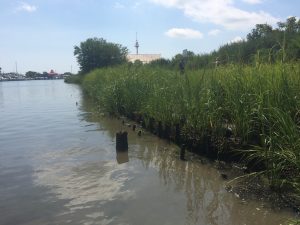
Facebook Twitter Instagram YouTube RSS Feed
Written on: May 22nd, 2017 in Living Shorelines
Guest Writers: Julie Molina, Katie Huegel and Matt Jones of DNREC’s Wetlands & Subaqueous Lands Section

Pictured above is an armored living shoreline used in a high energy area. The project stabilized 150 linear feet of shoreline using a marsh toe sill with coir fiber logs and wetland vegetation planted behind the sill.
Delaware’s coastal communities face constant challenges from shoreline erosion. Historically, tidal wetlands act as the natural solution for shoreline stabilization. Tidal wetlands provide protection against shoreline erosion, a mechanism for flood control and natural habitat for many plant and animal species. Coastal communities today can still take advantage of having a natural means to stabilize their shorelines!
Having a natural, “living” shoreline is an increasingly popular option that provides a variety of ecological benefits while also serving a homeowner’s main goal of erosion control. For those with an interest in fishing and crabbing, the regaining of this critical riparian habitat has been proven to almost double the densities of these creatures when compared to bulkhead or riprap.
So what’s the next step?

Pictured above is a non-structural living shoreline in a low energy area. The project stabilized 84 linear feet of shoreline using coir fiber logs and wetland vegetation.
There are many different designs used when installing a living shoreline. From using coir fiber logs, to oyster castles, to a marsh toe sill with wetland plantings – the possibilities are endless. Since every shoreline is different, a site-specific design is required for successful results. Getting in contact with a consultant or contractor in order to determine which type of living shoreline would work for your property is an important next step. You can reach a consultant or contractor specializing in vegetative shoreline stabilization techniques here.
The Wetlands and Subaqueous Lands Section at DNREC has an expedited permitting process to authorize the construction of these natural living shorelines.
As long as the project meets the parameters outlined here, the Statewide Activity Approval for Shoreline Stabilization Projects can be used by coastal community residents to naturally protect their shoreline. For more information on natural living shorelines, please contact our office at (302) 739-9943.